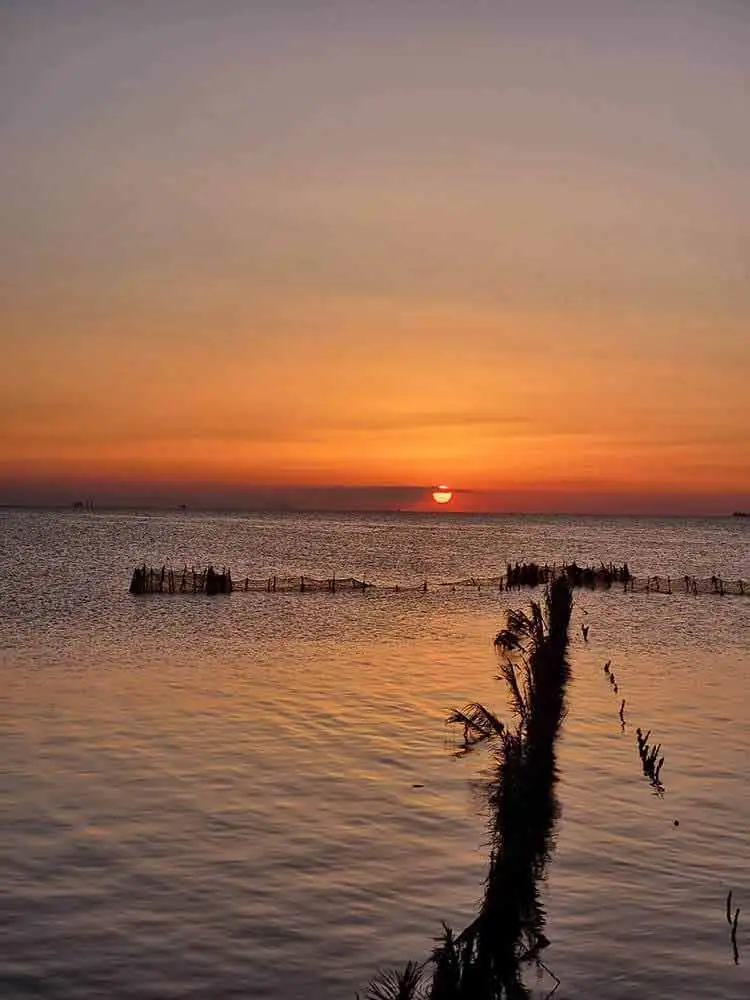Tunisia filming locations have become a hotbed of cinematic creativity in recent years, beckoning filmmakers with their diverse array of landscapes. From ancient ruins whispering tales of forgotten empires to pristine beaches lapped by turquoise waters, historic Medinas brimming with vibrant life, and beautifully adorned old houses holding secrets within their walls – Tunisia offers a multifaceted canvas for filmmakers to explore. This essential aspect of filmmaking, location scouting, takes on a whole new meaning in Tunisia, where every corner holds the potential to elevate the visual aesthetics and shape the storytelling experience in captivating ways. Embark on an extended virtual location scouting journey with us as we delve deeper into the cinematic potential of Tunisia’s varied environments.

The sunset in Tunisia beach
Ancient Ruins of Tunisia:
Tunisia’s landscape is a living testament to its rich history, adorned with ancient ruins that beckon filmmakers seeking to transport their audiences to different eras. At the forefront is the ancient city of Carthage, a UNESCO World Heritage Site boasting well-preserved archaeological wonders. This historical treasure trove features theaters, baths, and temples that not only provide a visual feast for viewers but also serve as a captivating setting for historical and fantasy films. Among its notable appearances, the ruins of Carthage played a pivotal role in the epic film “Gladiator,” showcasing the country’s ability to seamlessly blend its rich history with modern cinematic needs.
The amphitheater of El Djem stands as another iconic location, capturing the essence of ancient Roman architecture. Resembling the grandeur of the Colosseum in Rome, the amphitheater’s haunting beauty creates a dramatic atmosphere, making it an ideal choice for filmmakers crafting historical dramas and action sequences. The interplay of light and shadow within the colossal structure adds an extra layer of visual intrigue, making El Djem a sought-after destination for those aiming to evoke a sense of awe in their audiences.
Location scouting becomes a captivating archaeological adventure in Tunisia, where a plethora of ancient sites enrich the cinematic tapestry.
With its UNESCO World Heritage status, stands as one of the most significant archaeological sites in the region. The ancient city reveals an impressive array of ruins, including theaters, baths, and temples, offering filmmakers an authentic glimpse into the grandeur of the Punic and Roman civilizations.
-
Oudhna:
Another archaeological gem, boasts the well-preserved Roman theater of Uthina, an ideal setting for historical dramas seeking an immersive experience.
-
El Djem’s amphitheater:
A Roman colosseum echo, awaits your epic. Sun-drenched stone, dramatic shadows, roaring crowds – your next historical masterpiece starts here. Dive into Tunisia’s cinematic past, where authenticity meets grandeur.
-
Zaghouan:
Known for its Roman temple dedicated to water deities, it provides filmmakers with a unique backdrop that blends history and natural beauty. The temple’s intricate architecture and scenic surroundings make it a captivating location for films with a mystical or historical theme.
-
Utic:
An ancient city near Bizerte, presents filmmakers with the ruins of a Roman colony. The well-preserved Capitol and the archaeological site’s overall layout offer a versatile setting for filmmakers aiming to recreate the ambiance of ancient Roman life.
Often referred to as “the best-preserved Roman small town in North Africa” is a UNESCO World Heritage Site that offers a comprehensive glimpse into Roman urban planning. The well-preserved theater, Capitol, and other structures make Dougga an excellent location for filmmakers aiming to capture the essence of Roman architecture and daily life.
A UNESCO World Heritage Site on Tunisia’s northeastern coast, is a unique Phoenician archaeological gem. Untouched by later modifications, it offers filmmakers an authentic setting with well-preserved ruins, providing a captivating glimpse into ancient maritime trade and culture. This evocative location adds to Tunisia’s diverse cinematic backdrops.
Tunisia’s archaeological richness extends beyond these sites, with each location offering a unique blend of history, architecture, and atmosphere. From Carthage’s grandeur to the intimate charm of Dougga, filmmakers have a myriad of options to choose from when seeking the perfect archaeological backdrop for their cinematic endeavors.
Scenic Coastlines and Sandy Retreats:
Tunisia’s coastal allure extends beyond cinematic history, drawing filmmakers to its breathtaking beaches that redefine the ordinary. The island of Djerba stands out with its white, sandy beaches and crystal-clear waters, offering a mesmerizing fusion of ancient history and natural beauty. Djerba’s versatility makes it a sought-after location, catering to a spectrum of narratives, from historical epics to contemporary tales, as pristine beaches unfold against a backdrop of ancient ruins.
Venturing along the rocky stretches and sandy expanses of Tunisia’s coastline unveils cinematic gems. From the captivating beaches of Hammamet to the rugged beauty of Cap Bon, filmmakers discover a diverse array of coastal backdrops that enrich their storytelling. Sidi Bou Said, renowned for its blue and white architecture, further enhances Tunisia’s beachfront allure. Its narrow cobblestone streets, adorned with vibrant bougainvillea, provide filmmakers with a unique and visually striking coastal setting that has graced the screens of many films seeking seaside charm.
Old Medinas and Beautiful Old Houses:
Tunisia’s UNESCO-designated old Medinas stand as captivating windows into the country’s rich history and culture, each offering filmmakers a unique backdrop for storytelling.
-
Medina of Tunis:
The Medina of Tunis unfolds as a mesmerizing labyrinth, boasting narrow alleyways, vibrant markets, and ornate mosques. Filmmakers exploring this historic site discover authentic locations that breathe life into their narratives. Adding to the allure are the beautiful old houses, architectural masterpieces showcasing intricate designs like mosaic tiles, wooden lattice work, and ornate doorways. The interplay of light and shadow on these structures enhances the visual appeal, providing an additional layer of storytelling potential.
-
Medina of Sousse:
Enclosed by medieval walls and winding streets. The Medina of Sousse is a cinematic canvas emphasizing the harmonious blend of historic architecture and residential charm. Filmmakers are drawn to the well-preserved medieval structures and the intimate atmosphere created by narrow streets. This unique ambiance adds depth to any narrative, allowing filmmakers to capture the essence of Tunisian history and daily life.
-
Medina of Kairouan:
A UNESCO World Heritage Site, Kairouan’s Medina is a living testament to Islamic history. Its narrow alleys reveal intricate tilework and ancient doorways, providing filmmakers with a timeless backdrop. The iconic Great Mosque adds grandeur to historical narratives, while the bustling souks offer vibrant settings for diverse cinematic needs. Kairouan’s Medina, with its cultural resonance, invites filmmakers to capture the essence of North African heritage in a visually captivating and authentic setting.
-
Medina of Monastir:
The Medina of Monastir unfolds with a distinctive charm, presenting filmmakers with narrow alleys and traditional markets. This Medina, with its unique character, provides a cinematic setting that combines historical authenticity with the vibrancy of local life.
-
Medina of Kef:
Kef’s Medina, with its own architectural identity, contributes to Tunisia’s cinematic wealth. Winding streets and historic structures create an immersive experience for filmmakers, offering a glimpse into the town’s cultural tapestry.
-
Medina of Bizerte:
Bizerte’s Medina, adorned with historical and cultural gems, is a visual treat for filmmakers. The blend of bustling markets, ancient structures, and seaside charm adds a dynamic layer to cinematic narratives set against the backdrop of this coastal town.
Tunisia’s Medinas collectively offer filmmakers a myriad of options, each with its own unique story to tell. Whether capturing the vibrant energy of markets, the intricate designs of old houses, or the timeless charm of winding streets, these UNESCO World Heritage Sites stand ready to enrich cinematic narratives with the magic of North African history and architecture.
-
Tunisia filming locations recap
Tunisia’s diverse landscapes, encompassing ancient ruins, breathtaking beaches, historic Medinas, and beautifully adorned old houses, offer an expansive canvas for filmmakers to paint their narratives. As the film industry continues to push boundaries, Tunisia stands ready to showcase its rich tapestry of locations to the world. This North African gem invites filmmakers to weave their stories against the backdrop of its captivating scenery, promising not only a visual feast but also an authentic and immersive experience for audiences. Whether capturing the grandeur of ancient civilizations or the intimate charm of historic residences, Tunisia offers filmmakers a wealth of possibilities, ensuring that each frame tells a story as rich and diverse as the landscapes that serve as its backdrop.
